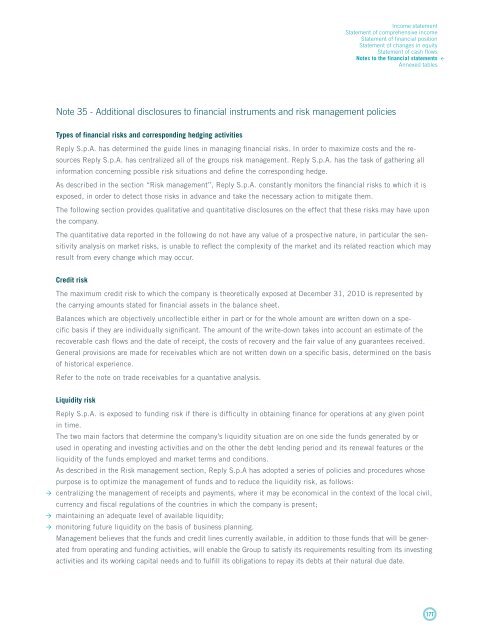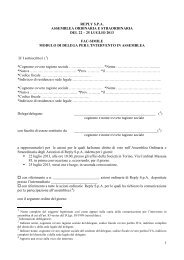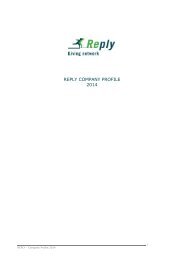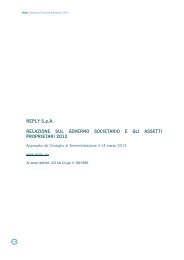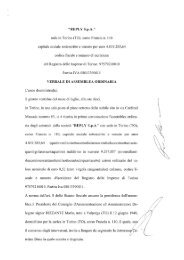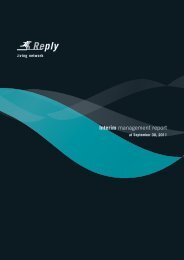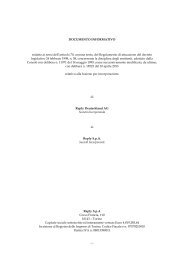Reply SpA
Reply SpA
Reply SpA
Create successful ePaper yourself
Turn your PDF publications into a flip-book with our unique Google optimized e-Paper software.
Income statement<br />
Statement of comprehensive income<br />
Statement of financial position<br />
Statement of changes in equity<br />
Statement of cash flows<br />
Notes to the financial statements<br />
Annexed tables<br />
<br />
Note 35 - Additional disclosures to financial instruments and risk management policies<br />
Types of financial risks and corresponding hedging activities<br />
<strong>Reply</strong> S.p.A. has determined the guide lines in managing financial risks. In order to maximize costs and the resources<br />
<strong>Reply</strong> S.p.A. has centralized all of the groups risk management. <strong>Reply</strong> S.p.A. has the task of gathering all<br />
information concerning possible risk situations and define the corresponding hedge.<br />
As described in the section “Risk management”, <strong>Reply</strong> S.p.A. constantly monitors the financial risks to which it is<br />
exposed, in order to detect those risks in advance and take the necessary action to mitigate them.<br />
The following section provides qualitative and quantitative disclosures on the effect that these risks may have upon<br />
the company.<br />
The quantitative data reported in the following do not have any value of a prospective nature, in particular the sensitivity<br />
analysis on market risks, is unable to reflect the complexity of the market and its related reaction which may<br />
result from every change which may occur.<br />
Credit risk<br />
The maximum credit risk to which the company is theoretically exposed at December 31, 2010 is represented by<br />
the carrying amounts stated for financial assets in the balance sheet.<br />
Balances which are objectively uncollectible either in part or for the whole amount are written down on a specific<br />
basis if they are individually significant. The amount of the write-down takes into account an estimate of the<br />
recoverable cash flows and the date of receipt, the costs of recovery and the fair value of any guarantees received.<br />
General provisions are made for receivables which are not written down on a specific basis, determined on the basis<br />
of historical experience.<br />
Refer to the note on trade receivables for a quantative analysis.<br />
Liquidity risk<br />
<strong>Reply</strong> S.p.A. is exposed to funding risk if there is difficulty in obtaining finance for operations at any given point<br />
in time.<br />
The two main factors that determine the company’s liquidity situation are on one side the funds generated by or<br />
used in operating and investing activities and on the other the debt lending period and its renewal features or the<br />
liquidity of the funds employed and market terms and conditions.<br />
As described in the Risk management section, <strong>Reply</strong> S.p.A has adopted a series of policies and procedures whose<br />
purpose is to optimize the management of funds and to reduce the liquidity risk, as follows:<br />
centralizing the management of receipts and payments, where it may be economical in the context of the local civil,<br />
currency and fiscal regulations of the countries in which the company is present;<br />
maintaining an adequate level of available liquidity;<br />
monitoring future liquidity on the basis of business planning.<br />
Management believes that the funds and credit lines currently available, in addition to those funds that will be generated<br />
from operating and funding activities, will enable the Group to satisfy its requirements resulting from its investing<br />
activities and its working capital needs and to fulfill its obligations to repay its debts at their natural due date.<br />
177


